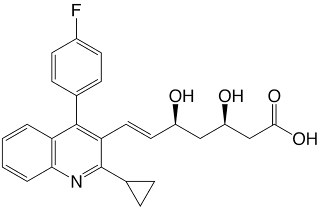New Drug Approvals - Pt. XIV - Pitavastatin (Livalo)
The latest FDA approval is Pitavastatin (trade name Livalo), approved on August 3rd. Pitavastatin is an HMG-CoA reductase inhibitor, indicated for the primary treatment of hypercholesterolemia (elevated levels of cholesterol in the blood) on patients unable to sufficiently lower their cholesterol levels by diet and exercise. Hypercholesterolemia is a very widespread and leads to serious cardiovascular disease in affluent and increasingly in developing societies.
Pitavastatin (also known by the research code NKS-104) has been available in Japan since 2003 and is now the sixth statin to reach the U.S. market, after Lovastatin (trade name Mecavor), Pravastatin (trade name Pravachol), Fluvastatin (trade name Lescol), Atorvastatin (trade name Lipitor) and Rosuvastatin (trade name Crestor). All of these drugs are derived from the natural product Mevastatin from the fungus Penicillium citrinum. Like the other statins, Pitavastatin lowers the cholesterol levels by competitively inhibiting HMG-CoA reductase, which is the rate-limiting enzyme of the mevalonate pathway of cholesterol synthesis. Inhibition of this enzyme in the liver results in decreased cholesterol synthesis as well as increased synthesis of low-density lipoprotein (LDL) receptors, resulting in a greater low-density lipoprotein cholesterol (LDL-C) clearance and overall reduction of cholesterol from the bloodstream. However, even in this relatively well studied area of biology, there are still many questions to be answered over cholesterol flux and pathogenesis.
Pitavastatin is small-molecule drug (Molecular Weight of 421.5 g.mol-1), and is fully Rule-of-Five compliant. Pitavastatin has a high bioavailability of 51%, and high protein plasma binding (ppb) of 99%), along with volume of distribution of 148 L and a half-life of 11 hours. Metabolism is primarily by glucuronidation (see below) but there is minor oxidative processing by CYP2C9 (and to a lesser by CYP2C8). The major metabolite isolated from human plasma is the lactone is formed via an ester-type pitavastatin glucuronide conjugate catalysed by UGT1A3 and UGT2B7. Excretion is primarily through feces (79% of dose). Typical dosage is of a single 2 mg tablet once a day (equivalent to a daily dose of 4.8 umol).

The structure (3R,5S,6E)-7-(2-cyclopropyl-4-(4-fluorophenyl)quinolin-3-yl)-3,5-dihydroxyhept-6-enoic acid contains a diol group with two defined stereocenters and a free carboxylic acid group (which mimic the mevalonic acid substrate of the enzyme). The acid group will make the drug negatively charged under physiological conditions and dominate its physical chemistry), common features among many synthetic statins. The remainder of the molecule is largely lipophilic and rigid.
Pitavastatin canonical SMILES: O=C(O)CC(O)CC(O)/C=C/c1c(c3ccccc3nc1C2CC2)c4ccc(F)cc4
Pitavastatin InChI: InChI=1/C25H24FNO4/c26-17-9-7-15(8-10-17)24-20-3-1-2-4-22(20)27-2 5(16-5-6-16)21(24)12-11-18(28)13-19(29)14-23(30)31/h1-4,7-12,16,1 8-19,28-29H,5-6,13-14H2,(H,30,31)/b12-11+
Pitavastatin InChIKey: VGYFMXBACGZSIL-VAWYXSNFBA
Pitavastatin CAS registry: 147511-69-1
Pitavastatin ChemDraw: Pitavastatin.cdx
The license holder is Kowa Pharmaceuticals and the product website is www.livalo.com

